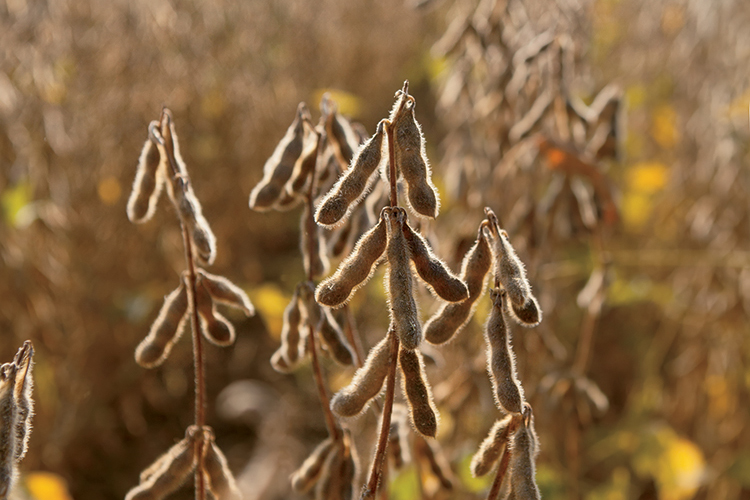Home > Mississippi > Mississippi Crops & Livestock > Scientific Methods
Scientific Methods
In partnership with: Mississippi Department of Agriculture and Commerce
 Bubba Simmons knows a good thing when he sees it. For more than 20 years, he’s been working with researchers from Mississippi State University’s (MSU) Delta Research and Extension Center (DREC) to improve his farm’s efficiency and profitability. Simmons’ farm, Simmons Planting Company, grows corn, soybeans and rice on 6,000 acres near Arcola. Simmons says the DREC, which operates out of Stoneville, Miss., in the heart of the Delta region, has offered assistance for all facets of his operation – from weed, disease and insect control to managing nutrients and irrigation. “[The DREC] is a great resource for all growers in the region. They’re able to come out to the farms, diagnose problems and offer viable solutions,” Simmons says. A constant obstacle for Delta farmers is water shortages due to a declining aquifer. The DREC works with growers to effectively manage water and minimize irrigation runoff. “The DREC has helped growers with some really good tools to use less water – such as PHAUCET, a computer program that allows us to use soil moisture sensors to make better decisions about when to irrigate,” Simmons says.
Bubba Simmons knows a good thing when he sees it. For more than 20 years, he’s been working with researchers from Mississippi State University’s (MSU) Delta Research and Extension Center (DREC) to improve his farm’s efficiency and profitability. Simmons’ farm, Simmons Planting Company, grows corn, soybeans and rice on 6,000 acres near Arcola. Simmons says the DREC, which operates out of Stoneville, Miss., in the heart of the Delta region, has offered assistance for all facets of his operation – from weed, disease and insect control to managing nutrients and irrigation. “[The DREC] is a great resource for all growers in the region. They’re able to come out to the farms, diagnose problems and offer viable solutions,” Simmons says. A constant obstacle for Delta farmers is water shortages due to a declining aquifer. The DREC works with growers to effectively manage water and minimize irrigation runoff. “The DREC has helped growers with some really good tools to use less water – such as PHAUCET, a computer program that allows us to use soil moisture sensors to make better decisions about when to irrigate,” Simmons says.
Weed ‘Em And Reap
Dr. Jason Bond, an associate research/extension professor with the DREC, says the number one problem for cotton, corn and soybean farmers is glyphosate resistance in various weed species, particularly Palmer amaranth, commonly called pigweed, and Italian ryegrass, which is a winter annual weed. In addition to testing new technologies and researching herbicide resistance traits, Bond and his team help growers formulate management programs with herbicides that are already on the market. “We’re trying to put new spins on old products. We have management programs in place for Palmer amaranth in cotton, corn and soybeans, and then we have a program in place for Italian ryegrass across all our major row crops,” Bond says. “Palmer amaranth can make 400,000 to 700,000 seeds on a single plant. Italian ryegrass is only going to make 40,000 to 50,000 seeds on a single plant, so the farmers who have been dealing with Italian ryegrass the longest who have been very aggressive in their management and been able to drop back into more of a maintenance program where they’re not having to spend as much money to control that one weed species. “Most of our research projects are very applied, so we’re taking problems we see in the field or that are communicated to us by growers and consultants, and we’re trying to replicate them in small-plot research to devise a solution to that problem.” 
Paying It Forward
Simmons says cost savings from those solutions can be passed on to consumers. “We’re able to produce crops more economically, and we’re able to produce crops using fewer natural resources,” Simmons says. “The most important industry we have in the Mississippi Delta is agriculture. Chemical suppliers, seed suppliers, transportation, all the growers, packers, the Delta ports – they all depend on the viability of the agriculture industry. The university research team is very important to that economic cycle. We couldn’t exist without them.” Bond says the DREC’s location helps strengthen the relationship with growers. “We’re right in the middle of the major crop-producing area of the state. We have a visible research location. Our phone rings constantly, and we deal with individuals, growers, consultants, and distributors on a one-on-one basis over the phone or on field calls,” Bond says. “We also conduct multiple field tours each year, and we host meetings with growers across the state during the fall and winter.” Growers can find a wealth of data, tips and techniques on the university’s Research and Extension System website, msucares.com. Bond says the row crop faculty at MSU publishes a crops blog (mississippi-crops.com) and manages a Facebook page and Twitter account to ensure researchers are communicating the latest information. “If we come across a problem, we can immediately put out a blog post that’s blasted to thousands of readers,” Bond says. “Most of us have Twitter accounts. I get a lot of good feedback from my Twitter feed, and I try to put out real-time information to show things like herbicide symptomatology or weed identification – at least as much as I can show with a photograph and 140 characters.”



